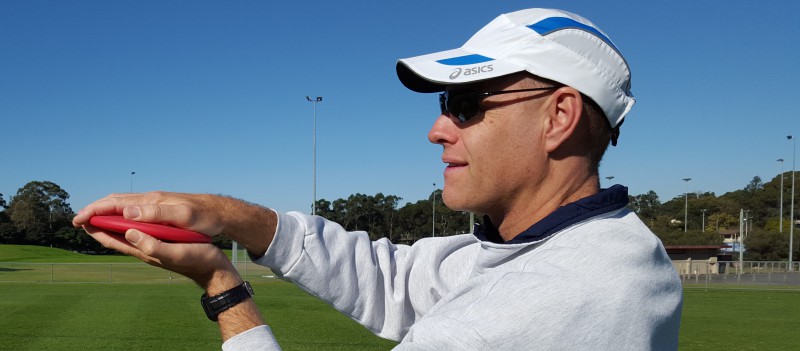Add These Hurdles Activities To Your Sessions When Coaching Young Athletes
Below is an image of the set up for two hurdles activities that I have used with a group of eight athletes, aged 8 to 10 years, immediately following their warm up game.
Looking at the set-up:
- Can you predict what the group did?
- How did I use each piece of equipment?
- What strategies am I intending to employ to keep the kids engaged?

How did you go? Below is an description of what I did. Let’s see how close you got.
Activity 1: Sprints Over the Mini Hurdles

I love teaching kids to run fearlessly over objects without hesitation. It is a key to effective hurdling and a wonderful contributor to the development of coordination.
In this activity, the kids simply run from start to finish line, quickly stepping over the hurdles in their lane.
Some things to note:
1. Height
The hurdles are initially set as low as they can go to promote a fluent and fearless action over the hurdles.
2. Spacing
The hurdles are randomly placed and spaced for easy set up, variety and to challenge the athletes’ spatial awareness.
3. Distance
The distance run is each time is only 20 metres. Short distances = more speed and less fatigue.
4. Activity Time
I have set up two lanes to ensure lots of turns and as little waiting time as possible.
5. Connection
Each time an athlete runs, they are working with a partner. This is great for connection within the group.
6. Coaching Cues
Instruct the kids to point their knees to the finish line as they step over the hurdle. The step should be a quick action; no leaping or floating over the hurdle. Make sure the kids step over – and not around – the hurdle.
7. Progression
The kids will initially run sub-maximally to familiarise themselves with the activity. Once I am satisfied that they can negotiate the hurdles without hesitation, I allow them to run as fast as they feel comfortable.
I will then introduce some fun competition, allowing them to race with a partner.
8. Variety
- Move the hurdles. Involve the kids by asking them to move the hurdles.
- Add or take away hurdles.
- If using adjustable hurdles, alter they height of some or all of the hurdles. Use varying heights within a lane.
- Set the hurdles up differently – space and/or height – in each lane so the challenge differs from lane to lane.
- Regularly ask the kids to change partners to facilitate connections throughout the group.
- Arrange for the kids to change lanes. Some of the smallest tweaks can retain the novelty of an activity.
- Have the kids start with a different foot forward and from various positions e.g. Kneeling, lying prone, sitting, etc.
Activity 2: Shoot the Target

This activity sees the kids practicing their lead leg action and their trail leg action by stepping or skipping past the hurdles and “shooting” the noodles with their lead and trail leg knees.
By using two rows of hurdles, up to four athletes can be working at once if you use both sides of the hurdles.
The pool noodles, standing vertically on a peg at the end of each lane, have two roles:
1. External Focus
Lead Leg
The kids are asked to “shoot” their lead knee and toes at the noodle. This will cause their lower leg to line up with the noodle, leading to the shin attaining a vertical position rather than swinging or flicking. A straight up and down action of the knee and lower leg is the aim.
Trail Leg
After pulling their trail leg past the hurdle, the kids are asked to “shoot” the noodle with the knee cap and toes of the trailing foot. The aim is to get the trailing knee fully around to the front and the shin into a vertical position to regain a good sprinting action between the hurdles.
2. Forward Motion
Kids will often lose focus and wander off to the side after clearing a final hurdle in an activity, resulting in a poor completion of the hurdle. Asking the kids to circle around the noodle prior to making their way back to the start will help them to maintain forward momentum after getting past the last hurdle.
Summary
Within these two activities we see:
- Elements that help build general coordination and specific hurdling skills.
- Lots of activity and potential for progression and variety to keep the kids engaged.
- Promotion of connection within the group as the kids work with partners and in small groups.
Recommended Action
When coaching hurdles skills:
- Get kids to sprint and step over mini hurdles.
- Use pegged-in pool noodles as an external focus for the lead and trail leg action.
I would love to hear how it works for you. You can let me know by leaving a comment/reply or by using the contact details below.
Further reading
The Best Tips For Teaching Kids How to Hurdle
How To Make Hurdles Really Fun For Kids
If this post helped you please take a moment to help others by sharing it on social media. If you want to learn more I encourage you to leave questions and comments or contact me directly.
 Darren Wensor is a sports development professional, coach educator, specialist coach of young athletes and founder of the blog coachingyoungathletes.com. Learn more about him here and connect with him on Twitter, Facebook, Linkedin, Anchor or via email.
Darren Wensor is a sports development professional, coach educator, specialist coach of young athletes and founder of the blog coachingyoungathletes.com. Learn more about him here and connect with him on Twitter, Facebook, Linkedin, Anchor or via email.
